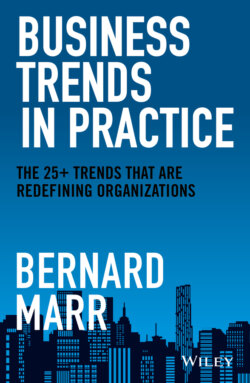Читать книгу Business Trends in Practice - Бернард Марр, Bernard Marr - Страница 24
Trend 3: The Datafication of Our World
ОглавлениеUbiquitous computing and the IoT are both huge contributors to the sheer volume of data that's being generated on a daily basis. But alongside machine-generated data, we humans are also generating masses of data through our daily activities. Everything we do leaves a digital trace. From liking a video on TikTok to buying gas with your credit card, so many of our everyday activities generate streams of data. As such, we've seen huge advances in the way data is stored. It's not just about data warehouses anymore; now we have data lakes, where data is stored in a less-structured way, with data rivers continuously flowing into those lakes. And, as I've already mentioned, we have futuristic advances such as DNA data storage to look forward to.
For businesses, the obvious advantage of all this data is that it can be harnessed to design better products and services, improve business processes, enhance decision-making, and even create new revenue sources (take a company like John Deere as an example, which has been able to package up the data collected from its farming machinery and sell it back to farmers).
Two of the biggest concerns around data are privacy and security. When everything we do leaves a digital trace, this can have massive implications for our individual privacy, so it's vital that businesses take steps to protect people's privacy. For me, this means only collecting data that you really need (and not collecting everything for the sake of it), making people aware of exactly what data you're collecting (and why), and offering them the chance to opt out where possible. Looking ahead, we can expect to see a significant tightening of regulations designed to protect people's privacy. Security-wise, while the number of breaches has declined since 2019, the severity of breaches has increased – to the extent that 37 billion sensitive records were compromised in 2020, an increase of 141 percent on the previous year.7 And in February 2021, the largest breach of all time was leaked online. COMB, or Compilation of Many Breaches, as it's being called, contained 3.2 billion emails and passwords – roughly 40 percent of the entire population of the planet.8 Data is a valuable asset, but it also brings with it considerable business risk.
Another risk, of course, is that companies simply drown in all this data. Thus it's essential that companies develop smarter approaches to turning data into insights – and, in turn, ensure that those data-driven insights can be translated into action. Businesses must work to raise data literacy across the organization, and this means all decision makers in the organization must have access to the data they need, understand the value of that data, and have a basic ability to use that data. As such, we can expect to see more and more organizations implementing data literacy programs.
Artificial intelligence will help to raise data literacy and accessibility. Indeed, many off-the-shelf cloud data storage solutions offer some form of AI capability to help businesses make sense of their data. Going forward, augmented analytics will play an increasingly key role. Driven by AI, augmented analytics essentially means systems can automatically detect patterns in data by themselves, without being programmed according to a specific set of rules, and then push insights out to users without having to be asked specific questions. In other words, data will become more democratized, meaning people right across the organization will be able to exploit data, without the need for data science skills. This data democratization is an exciting trend to watch, and is just one of many advantages that have sprung from the rise of AI, which brings us to another trend.
